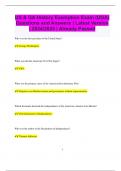Exam (elaborations)
Test Bank - For Modern Advanced Accounting In Canada 9th Edition by Hilton Murray, Herauf Darrell
Test Bank for Modern Advanced Accounting In Canada 9th Edition Hilton Murray, Herauf Darrell. CHAPTER 1 Conceptual and Case Analysis Frameworks for Financial Reporting CHAPTER 2 Investments in Equity Securities CHAPTER 3 Business Combinations CHAPTER 4 Consolidation of Non-Wholly Owned Subsidiaries...
[Show more]












